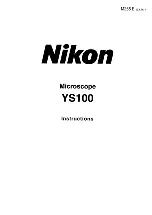
Chapter 4
Functions and Operations of the Devices
50
12
Diascopic Illuminators
The primary diascopic illuminator for this microscope system consists of a stand equipped with an illuminating optical system.
A dark-field illuminator and polarizing illuminator are also available.
12.1
P-DSL32 LED Diascopic Illumination Stand
The P-DSL32 is a stand equipped with diascopic illumination optical systems and the focus mechanism of the support pillar
vertical movement type.
Attach a C-FMCN Focus Mount to the support pillar.
The base with a large glass plate (180 mm dia.) enhances usability and enables easier observation of samples in a container
such as a petri dish.
A dedicated hex driver is located at the top of the support pillar.
Sliding mechanism of the stage plate
The sliding parts are mounted on the base part for mounting the stage plate, which can be slid by loosening the stage
plate fixing screw. There is a clearance gap of approximately 3 mm around the stage plate when the stage is securely set.
The stage plate can be smoothly and finely moved within the clearance gap by loosening the stage plate fixing screw.
This mechanism is useful for positioning, especially for high-magnification observation.
Securely fix the stage plate in place using the fixing screw when this mechanism does not need to be used.
CTRL
CTRL
INPUT
12VDC ,
3.5A
ON OFF
Left side
P-DSL32 LED Diascopic Illumination Stand
Power supply and illumination control
Power to the P-DSL32 LED Diascopic Illumination Stand is supplied by connecting a P2-CTLB Control Box or a 12 V AC
adapter. To provide diascopic illumination without using a control box, connect a 12 V AC adapter.
Turn on or off the LED diascopic illumination using the LED power ON/OFF switch at the front of the base.
Adjust illumination using the LED brightness control dial on the base. To enable adjustment using the LED brightness
control dial on the base, the LED brightness control selection switch must be turned off.
[When the power is supplied from a control box]
When a P2-CTLB Control Box is connected to the base, turn on the LED brightness control selection switch. In this state,
diascopic illumination can be turned on or off, brightness can be controlled, and light intensity can be monitored from the
control box.
Actual control is carried out by the PC (software: NIS-Elements) connected to the control box.
Note that illumination cannot be controlled from the control box, even if the LED brightness control selection switch is
turned on, unless the LED power ON/OFF switch on the base is turned on. Be sure to turn on the LED power ON/OFF
switch.
Stage plate
fixing screw
LED brightness control
selection switch
LED brightness control terminal
AC adapter input
terminal
Support pillar
Stage plate
OCC adjustment knob
LED brightness control dial
Focus dial
LED power ON/OFF switch
Summary of Contents for SMZ1270
Page 1: ...Stereo Microscope SMZ800N SMZ1270 SMZ1270i Instruction Manual M609 E 18 5 NF 7 1 2 M609EN07 ...
Page 2: ......
Page 18: ...Chapter 1 Components 4 ...
Page 22: ...Chapter 2 Microscopy Procedures 8 ...
Page 96: ...Chapter 5 Assembly 82 ...
Page 102: ...Chapter 7 Maintenance and Storage 88 ...
Page 103: ...89 Chapter 8 Specifications ...
















































